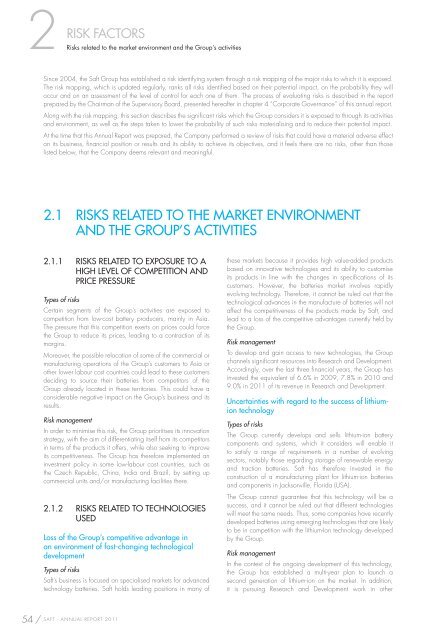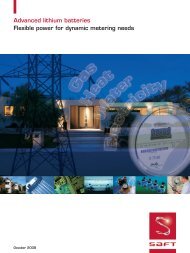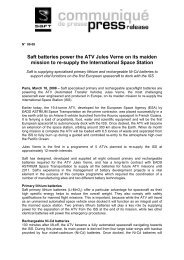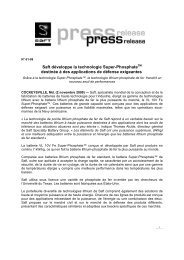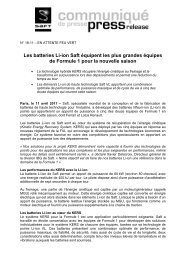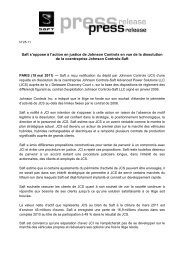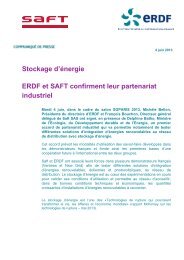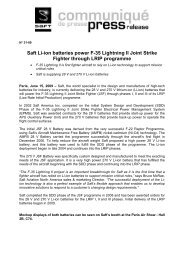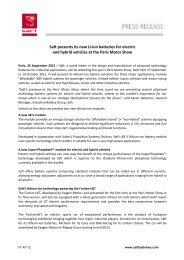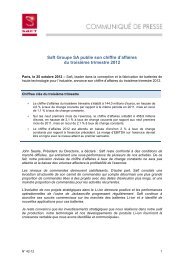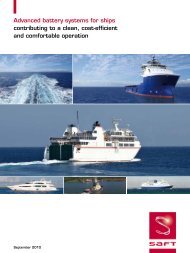ANNUAL REPORT 2011 REGISTRATION DOCUMENT - Saft
ANNUAL REPORT 2011 REGISTRATION DOCUMENT - Saft
ANNUAL REPORT 2011 REGISTRATION DOCUMENT - Saft
Create successful ePaper yourself
Turn your PDF publications into a flip-book with our unique Google optimized e-Paper software.
2 Risks<br />
RISK FACTORS<br />
related to the market environment and the Group’s activities<br />
Since 2004, the <strong>Saft</strong> Group has established a risk identifying system through a risk mapping of the major risks to which it is exposed.<br />
The risk mapping, which is updated regularly, ranks all risks identifi ed based on their potential impact, on the probability they will<br />
occur and on an assessment of the level of control for each one of them. The process of evaluating risks is described in the report<br />
prepared by the Chairman of the Supervisory Board, presented hereafter in chapter 4 “Corporate Governance” of this annual report.<br />
Along with the risk mapping, this section describes the signifi cant risks which the Group considers it is exposed to through its activities<br />
and environment, as well as the steps taken to lower the probability of such risks materialising and to reduce their potential impact.<br />
At the time that this Annual Report was prepared, the Company performed a review of risks that could have a material adverse effect<br />
on its business, fi nancial position or results and its ability to achieve its objectives, and it feels there are no risks, other than those<br />
listed below, that the Company deems relevant and meaningful.<br />
2.1 RISKS RELATED TO THE MARKET ENVIRONMENT<br />
AND THE GROUP’S ACTIVITIES<br />
2.1.1 RISKS RELATED TO EXPOSURE TO A<br />
HIGH LEVEL OF COMPETITION AND<br />
PRICE PRESSURE<br />
Types of risks<br />
Certain segments of the Group’s activities are exposed to<br />
competition from low-cost battery producers, mainly in Asia.<br />
The pressure that this competition exerts on prices could force<br />
the Group to reduce its prices, leading to a contraction of its<br />
margins.<br />
Moreover, the possible relocation of some of the commercial or<br />
manufacturing operations of the Group’s customers to Asia or<br />
other lower labour cost countries could lead to these customers<br />
deciding to source their batteries from competitors of the<br />
Group already located in these territories. This could have a<br />
considerable negative impact on the Group’s business and its<br />
results.<br />
Risk management<br />
In order to minimise this risk, the Group prioritises its innovation<br />
strategy, with the aim of differentiating itself from its competitors<br />
in terms of the products it offers, while also seeking to improve<br />
its competitiveness. The Group has therefore implemented an<br />
investment policy in some low-labour cost countries, such as<br />
the Czech Republic, China, India and Brazil, by setting up<br />
commercial units and/or manufacturing facilities there.<br />
2.1.2 RISKS RELATED TO TECHNOLOGIES<br />
USED<br />
Loss of the Group’s competitive advantage in<br />
an environment of fast-changing technological<br />
development<br />
Types of risks<br />
<strong>Saft</strong>’s business is focused on specialised markets for advanced<br />
technology batteries. <strong>Saft</strong> holds leading positions in many of<br />
54 / SAFT - <strong>ANNUAL</strong> <strong>REPORT</strong> <strong>2011</strong><br />
these markets because it provides high value-added products<br />
based on innovative technologies and its ability to customise<br />
its products in line with the changes in specifi cations of its<br />
customers. However, the batteries market involves rapidly<br />
evolving technology. Therefore, it cannot be ruled out that the<br />
technological advances in the manufacture of batteries will not<br />
affect the competitiveness of the products made by <strong>Saft</strong>, and<br />
lead to a loss of the competitive advantages currently held by<br />
the Group.<br />
Risk management<br />
To develop and gain access to new technologies, the Group<br />
channels signifi cant resources into Research and Development.<br />
Accordingly, over the last three fi nancial years, the Group has<br />
invested the equivalent of 6.6% in 2009, 7.8% in 2010 and<br />
9.0% in <strong>2011</strong> of its revenue in Research and Development.<br />
Uncertainties with regard to the success of lithiumion<br />
technology<br />
Types of risks<br />
The Group currently develops and sells lithium-ion battery<br />
components and systems, which it considers will enable it<br />
to satisfy a range of requirements in a number of evolving<br />
sectors, notably those regarding storage of renewable energy<br />
and traction batteries. <strong>Saft</strong> has therefore invested in the<br />
construction of a manufacturing plant for lithium-ion batteries<br />
and components in Jacksonville, Florida (USA).<br />
The Group cannot guarantee that this technology will be a<br />
success, and it cannot be ruled out that different technologies<br />
will meet the same needs. Thus, some companies have recently<br />
developed batteries using emerging technologies that are likely<br />
to be in competition with the lithium-Ion technology developed<br />
by the Group.<br />
Risk management<br />
In the context of the ongoing development of this technology,<br />
the Group has established a multi-year plan to launch a<br />
second generation of lithium-ion on the market. In addition,<br />
it is pursuing Research and Development work in other


